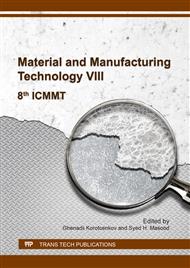p.59
p.64
p.69
p.79
p.84
p.90
p.95
p.101
p.105
Nanostructured TiO2 Materials: Preparation, Properties and Potential Applications (3P’s)
Abstract:
Nanostructured materials are a new class of materials which provide one of the greatest potentials for improving performance and extended capabilities of products in a number of applications. In particular nanostructured TiO2 was used as photocatalysts, gas sensor, solar cells and nanocomposite biomaterials. For each of these applications, aspects such as surface morphology, crystallinity and chemistry of the titania-based materials are the key parameters to be settled for the process optimization. A series of nanostructured TiO2 materials (TiO2 nanotubes, TiO2 nanorods, TiO2 nanoparticles) was synthesized using simple hydrothermal methods. X-Ray Diffraction (XRD), Field Emission Scanning Electron microscope (FESEM) and Brunauer–Emmett–Teller (BET) surface area characterization was carried out to study the properties of synthesized nanostructured TiO2 materials. The performance of synthesized nanostructured TiO2 was evaluated for various applications such as photocatalyst for methyl orange (MO) degradation and anti-bacterial thin film for biomedical and food packaging. Among the nanostructured TiO2 materials, TiO2 nanotubes shows the highest activity regardless of their applications. This is probably due to their nanotubular morphology in which provided high surface area materials. The surface area of TiO2 nanotubes was found to be 226.52 m2/g. The outer and inner diameters of nanotubes are 4 nm and 10 nm, respectively with several hundred nanometers in length. Anatase TiO2 phase structure and crystallinity of TiO2 nanotubes supports the good performances of the nanostructured materials.
Info:
Periodical:
Pages:
84-89
Citation:
Online since:
October 2017
Keywords:
Price:
Сopyright:
© 2017 Trans Tech Publications Ltd. All Rights Reserved
Share:
Citation:


